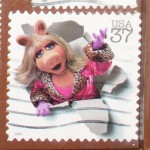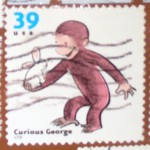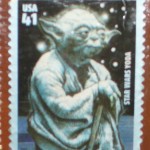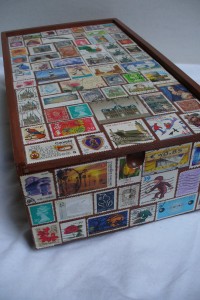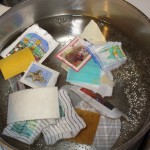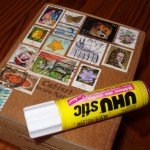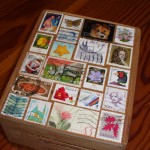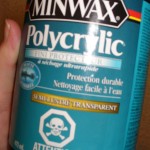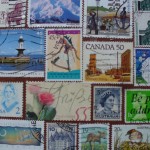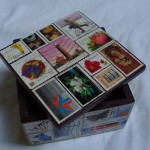This is a long one but a good one, promise. Got lots of time to kill this weekend? Then this could be just the project for you.
Warning: if you are a serious stamp collector – if you steam stamps off of envelopes and keep them in little plastic sleeves – stop reading now. This craft will have you tearing out your hair and screeching about the mistreatment of valuable collectables. Otherwise, read on.
I love postage stamps. The colours, the designs! My mom (a member of the dying breed of avid and delightful letter-writers) and I play a little game, finding the most interesting possible stamps to put on our mail to one another. Among the best I’ve received from her are a stamp featuring the Very Hungry Caterpillar, one flaunting the classy and classic Miss Piggy, and another displaying Curious George. My best friend once sent me a parcel with a Yoda stamp affixed.
Obviously you just can’t throw these out! I’ve been tearing stamps off letters and saving them in a box since I was a kid, mostly for that magpie joy of collecting. Plus stamps are pretty and interesting. But a few years ago, my mom (yep, the credit for this craft goes to her) came up with a way to make use of all that used postage.
Wallpaper!
Well no, not really wallpaper. But you can wallpaper your stuff with them. Boxes, magazine holders, an old wooden stepstool, trays. It looks way spiffy, especially if your decor already leans towards the I’m-a-crazy-awesome-artiste-type-who-knows-what-mauve-is-and-once-rented-a-shoebox-apartment-in-Paris’-Latin-Quarter style.
Really, though, see below. You can cover an entire box in stamps (as long as you have enough stamps), and it will be a great unique storage device and conversation piece.
Here’s how to do it:
1) Find a box or any other item you wish to decorate. In the example below, I used a wooden wine box I found in the recycling bin. Other possibilities include cigar boxes, jewelry boxes, picture frames, stepstools and other small pieces of furniture, or anything else you can think of. Wood is a good material because it’s sturdy, but you could also use stuff made of nice thick solid cardboard. You could even cover a canvas in stamps and hang it on the wall.
The important thing, at least for your first attempt, is to find an object you can make use of (you don’t want to use your favourite stamps on something you won’t like or use), an object that is sturdy and durable, and an object without weird shapes or angles or bumps, as that’ll make it much harder to apply the stamps to the surface.
1.5) If necessary (if the wood or cardboard is old, grotty, covered in writing or you just don’t like the colour) paint your object. Acrylic will work just fine – you’ll be sealing it all later, after the stamps are applied. Give it several good coats.
2) Prepare your stamps. To get them off the paper backing of the envelope, simply soak the stamps (a few at a time) in a pot of simmering water. No, this will not wreck them! Occasionally, on a few stamps, the ink may fade a bit, but I’ve only had this happen rarely. Let them sit in the simmering water until the paper falls off the back of the stamp (usually takes 1-2 minutes). Then scoop the stamps out (I use a fork) and put them upside down (so they don’t stick) on a cooling rack (those things you use for baking), and let them dry completely. Don’t worry if they curl – you can flatten them later.
3) When your stamps are dry, lay them out on your object to determine their pattern.
I do this in steps. First, I usually trace the object onto a sheet of paper. Example, I trace around one side of the box, and lay my stamps out on that sheet of paper. It’s just easier that way. DO NOT start gluing down stamps without planning your layout first – it will not end well. Unless you’re some sort of all-round genius who can tell whether x number of stamps will fit perfectly into y space, in which case what are you doing reading this tutorial and not out saving the world or at least convincing FOX to give Joss Whedon the chance to make a good show without screwing him over from the start (which is pretty much equivalent to saving the world)?
Righto. So, plan ahead. Do it in pieces. Lay out once side of your box and glue those stamps in place, then do the next side, etc.
You may wish to center the whole design around one particular stamp. You may wish to leave big gaps between each stamp, or very little space at all. You may wish to leave a portion of your object un-stamped, and paint a design or a name or a logo on it. Do whatever pleases you! That is what making your own cool stuff is all about, after all.
4) Glue the stamps down. Do it well! Make sure you get glue all the way to the edges and on all the corners of every stamp. You don’t want them peeling off later.
Use a glue stick, not white glue – white glue will make the stamps more prone to bubbling up or curling or getting air pockets underneath. As with all things, there are glue sticks and there are glue sticks. This just means trying out a couple brands until you find one that really, y’know, sticks.
5) Once you’ve covered your whole box/frame/headboard/pet elephant in stamps, you are ready to seal it. Get a small can of sealant from the hardware store (and save the tons you’ll have left over for some other future project).
You’ll have the option of oil-based or water-based. Oil-based is good because it doesn’t make the stamps as prone to bubbling up. On the other hand, it’s more of a misery to clean off your brushes. Water-based also works fine, and is no problem to clean. I use water-based, but if you go this route you’ll need to be a bit more careful to put on thin coats, or the stamps will warp.
Following the instructions on the can, coat your object in sealant. As in the shower, lather, rinse & repeat at least 2 or 3 times, letting it dry in between coats. The more coats, the better protected and longer-lasting your work of art will be. (This stuff isn’t too expensive – I think I paid about $7 for that small can. Thing is, if you seal the can back up properly it’ll keep for ages, and it’s highly useful to have around for a whole variety of crafts and tasks.)
6) Bask in the glory of a craft well done! Display your newly decorated item proudly and prominently. Possibly buy yourself a giant gooey piece of chocolate cake to celebrate.
Other Ideas – Try decorating a smaller piece using all stamps of a certain theme. Example, a jewelry-sized box covered in German stamps, or flag stamps, or stamps with the faces of queens, kings, presidents and rock stars. I once made my parents Christmas tree ornaments using this technique. My mom’s was covered in Christmas-themed stamps, my dad’s in stamps depicting various Madonna and Child’s (it was amazing how many of those I had in my collection). Both turned out very well.
If you don’t have any used stamps because you didn’t collect such things as a child and then obsessively cart them around with you when you grew up and moved across the continent, well, this might be a great incentive to start writing more letters. Give and you shall receive!
[NOTE]
I’ve had a suggestion to laquer these in a glossy finish. This is indeed a great idea if you want to make it pop a bit more and really shine (haha). Think I’ll try it on my next one.


